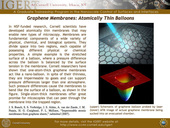Highlight
Graphene Membranes: Atomically Thin Balloons
Achievement/Results
In NSF-funded research, Cornell scientists have developed atomically thin membranes that may enable new types of microscopy. Membranes are fundamental components of a wide variety of physical, chemical, and biological systems. They divide space into two regions, each capable of possessing different physical or chemical properties. A simple example is the stretched surface of a balloon, where a pressure difference across the balloon is balanced by the surface tension in the membrane. Cornell researchers have shown that one-atom-thick graphene membranes act like a nano-balloon. In spite of their thinness, they are impermeable to gases and can support pressure differences larger than one atmosphere. Such pressure differences cause the membranes to bend like the surface of a balloon, as shown in the figure. Single-atom-thick membranes offer great promise for micoscopies that can peer through the membrane into the trapped region.
Address Goals
This activity addresses the “Discovery” strategic goal by demonstrating that single-atom-thick impermeable membranes fabricated from graphene sheets can be used to seal micron-scale openings. These membranes can withstand pressure differentials larger than 1 atmosphere without rupture.
This activity addresses the “Learning” strategic goal by educating four doctoral candidates in an area of national need — nanoscale science. One of these candidates, Mr. Jonathan Alden, is an IGERT Fellow.






